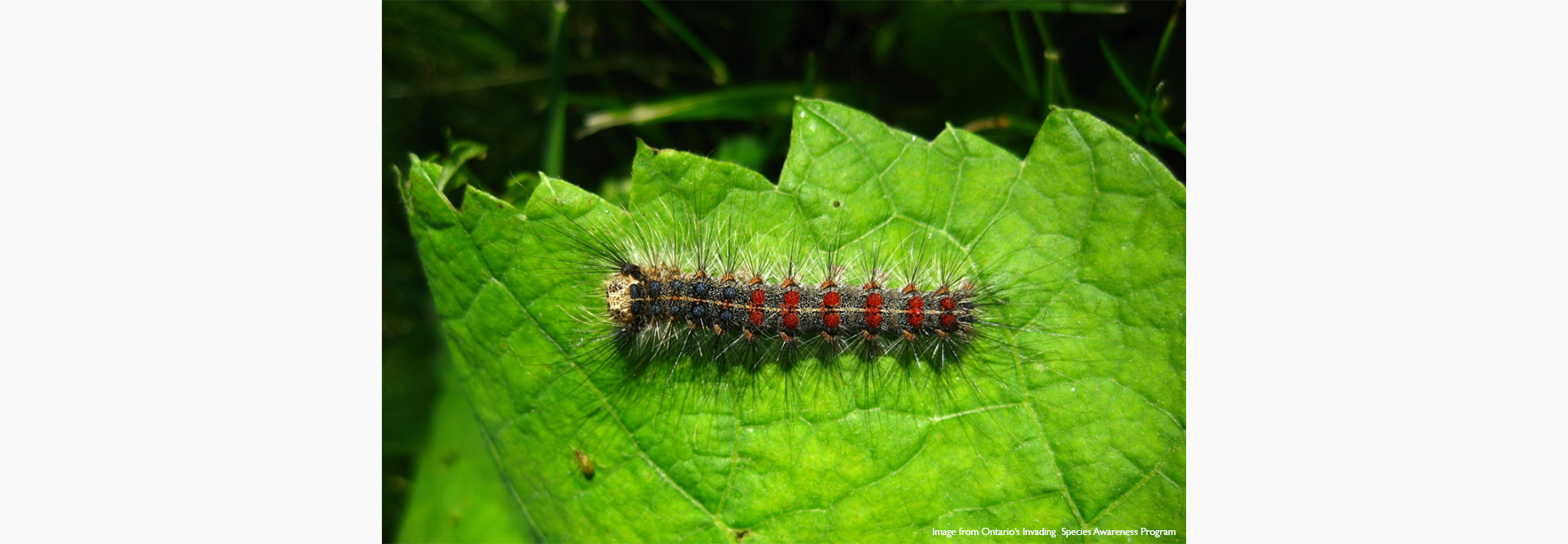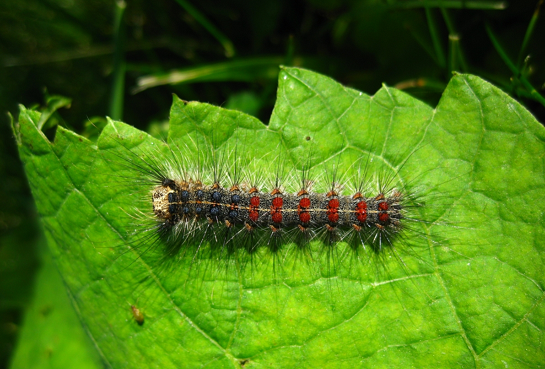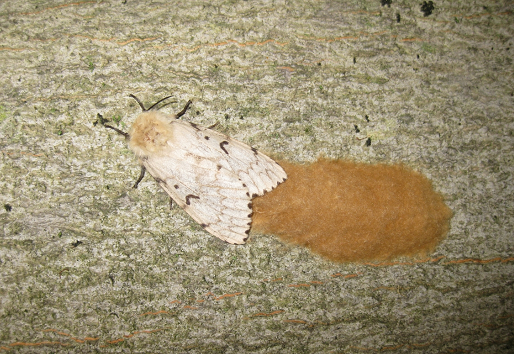
Note: In an effort to use inclusive language, Middlesex Centre is moving away from the use of "gypsy moth" and will be using the term "spongy moth" going forward.
Spongy moth (Lymantria dispar dispar) is an invasive species that is severely weakening trees across North America. Unfortunately, parts of Middlesex Centre are experiencing an infestation of spongy moth.
Spongy Moth Program Updates
Sign up to get information about the Municipality of Middlesex Centre's Spongy Moth Program sent straight to your inbox.
Sign-Up for Spongy Moth Program Updates
- What happens during an infestation?
-
Spongy moth outbreaks occur every 7 to 10 years. LDD moth caterpillars (“larvae”) will chew holes in leaves, and may partially or totally strip a host tree of its leaves.
During outbreak years, nearly all broadleaf (hardwood) trees may be completely defoliated. This can harm and even kill otherwise healthy trees. Caterpillars appear everywhere and their droppings ("frass") will fall from the trees.
This species is known to infest trees in woodland or suburban areas. They prefer to infest hardwood species, such as oak, birch, poplar, willow, maple and others.
- What does a spongy moth look like?
-
Photos courtesy of Ontario's Invading Species Awareness Program
Caterpillars are 5-6 centimetres long with five pairs of blue dots and six pairs of bright red dots along their back.
Female moths are white with dark markings and cannot fly. Male moths are brown and can fly. Females are larger than males with a 5 cm wing span, males only span 2.5 cm.
Egg masses are about 4 cm long, tan coloured, and can be found on tree trunks, furniture, buildings, etc. You may see spongy egg masses on the trunks and branches of infected trees beginning in late July.
- Where are spongy moths found in Middlesex Centre?
-
While they can be found anywhere in Middlesex Centre, there are particularly heavy infestations in the Westbrook Park area in Kilworth and in portions of Ilderton and Arva.
- What is Middlesex Centre doing about spongy moths?
-
2022 Spongy Moth Program
Middlesex Centre is undertaking an aerial spray for spongy moth infestations on municipal woodlots in Kilworth and Ilderton in 2022.
2022 Spongy Moth Aerial Spray Program
2021 Aerial Spraying Program
Based on the findings from the field study conducted earlier in 2021, Middlesex Centre undertook an aerial spray for spongy moth infestations on municipal woodlots in Kilworth and Ilderton.
2021 Field Study
In 2021, Middlesex Centre contracted Stantec Consulting to undertake a LDD Moth Field Survey starting in February. The study saw research observers conduct a walkthrough of identified study areas. The observers counted all the spongy moth egg masses and capture data on the size and location (type of tree) of the masses, as well as information on the health of the trees.
The study areas were Westbrook Park, the Jefferies Rd. Pump Station, a private woodlot in Komoka, and the area from the Ilderton Rail Trail to the Fire station.
Following the walkthrough, research plots in those areas most susceptible to spongy moths were examined in more detail.
After the research concluded, Stantec prepared a report outlining appropriate spongy moth management options and a cost-benefit analysis. The report was presented to Council consideration on April 14, 2021.
Spongy (LDD) Moth Field Study Report, 2021
2020 Treatment Program
In 2020, we worked with a local arborist to treat the municipal portion of the tree lot at Westbrook Park in Kilworth. As this involved bringing in specialized equipment from out of the area, we arranged with the arborist to provide a flat rate per household for homeowners wishing to treat their individual properties.
- What can homeowners do to control spongy moths?
-
Homeowners are encouraged to monitor their hardwood trees like oaks, maples, beech and walnut for the presence of spongy moth caterpillars.
solutions and Treatments
Here are some general recommendations for dealing with spongy moths on your property:
- Keep your trees in good health.
- Install pheromone traps in trees to lure and trap male moths to prevent them from mating with female moths. Consult your local nursery or hardware store for information on the proper use of these traps.
- Use burlap bands. As the weather warms in late May and June, caterpillars tend to feed at night, and climb down the tree to shelter from the heat during the day. Wrap burlap or light-coloured cloth around tree trunks to collect the caterpillars. Fold the burlap back over itself to create a cavity, and the caterpillars will collect in there. Once a day, scrap the caterpillars off the burlap into a bucket of soapy water, then re-apply the burlap. This will help reduce the number of caterpillars in your tree. This technique may also be used later in the summer to collect female moths (which are unable to fly and so will climb up the tree to lay their eggs.)
- Physically remove and destroy egg masses. This is one of the best ways to reduce the infestation - every egg mass removed will reduce the population by several thousand! Use a small paint scrapper or other gentle tool to remove the egg masses. Soak the egg masses in soapy water overnight to kill them, and then they can be bagged and sent to the landfill. Don’t drop them on the ground or put them in your composter as the caterpillars will still emerge. See the City of London’s video to see how to remove the egg masses. The best time to remove the masses is in the fall after the leaves have fallen. Try to avoid windy days if possible.
- Contact an arborist if you think a tree on your property is being heavily defoliated by spongy moths. Insecticide treatments may be necessary.
- Contact the municipality if you think a tree on municipal property is being heavily defoliated by spongy moth. Please include the street address in your message.
- Where can I get learn more?
-
Information for this article was taken from the following websites:
- Ontario's Invading Species Awareness Program
- Province of Ontario
- City of Hamilton
- Davey Tree
- Ausable Bayfield Conservation
Additional information sources:
Questions
If you have questions regarding the municipality's response to spongy moths, please contact Scott Mairs, Director of Community Services.

